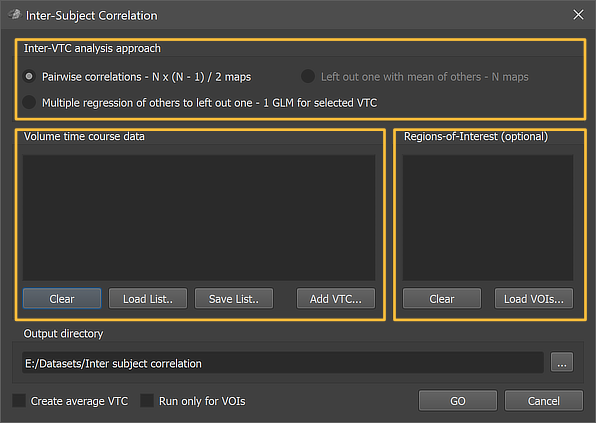BrainVoyager v23.0
Inter-Subject Correlation (ISC) Analysis
Introduction
Inter-Subject Correlation (ISC) analysis measures the consistency of stimulus-locked responses across individuals by correlating evoked fMRI time courses. ISC complements other analysis methods by revealing brain regions with activity that is consistently driven across participants (or runs or sessions) without the need of a pre-defined design matrix (similar as ICA). If subjects, for example, see the same movie or listeni to the same story, brain regions that are systematically driven by the movie or story will fluctuate synchronously across participants leading to high correlation values. Brain regions that do not process the stimuli in the same way across individuals, or that do not respond to the stimuli, will not produce high pairwise correlation values. Between these two extremes, intermediate correlations are expected in case that voxels activate to the same stimuli but with response profiles that are not precisely time-locked (more or less delayed, shorter or longer); such partially similar responses may, for example, occur in response to complex emotional stimuli. As indicated, ISC experiments often employ complex, naturalistic stimuli such as movies but any task can be used as long as the time course of stimulation is the same across runs. ISC can, thus, not only be used for inter-subject correlation but also for inter-run correlations of datasets from the same individual (e.g. runs within a session) as long as the same stimulation protocol is used. Since noise fluctuations and idosyncratic responses cancel out in pairwise correlations, ISC also provides an interesting approach for denoising datasets effectively filtering out subject-specific signals.
The ISC implementation in BrainVoyager provides methods for whole-brain datasets as well as for a set of provided regions-of-interest (VOIs). The method enabled as default runs pairwise correlations of a provided list of 4D time course (VTC) files. A second methods calculates the correlation of each provided 4D dataset with the mean of all other datasets (available soon). A third method uses multiple regression (GLM) analysis to relate the fluctuations of a target (participant) time course to the weighted sum of predictor time courses coming from other (participants) time courses When applying ISC to regions-of-interest, the program produces correlation matrices for extracted mean regional volume time courses. Note that the statistical assessment of ISC group (second-level) effects are challenging. Appropriate recommendations for group comparisions using parametric tests as well as non-parametric tests will be provided in a subsequent release.

The Inter-Subject Correlation dialog (see screenshot above) can be launched by clicking the Inter-Subject Correlation (ISC) Analysis item in the FuncConn menu. The Inter-VTC Analysis Approach section provides the different methods that can be used to perform inter-subject correlation analysis with the Pairwise correlation option selected as default. The option's name contains also an indication how many correlation maps will be produced (N * (N - 1) / 2) when using this approach. The Volume time course data section and the Regions-of-Interest section are used to provide input data for whole-brain based ISC and / or ROI-based ISC analysis.
Copyright © 2023 Rainer Goebel. All rights reserved.